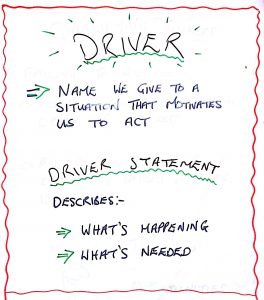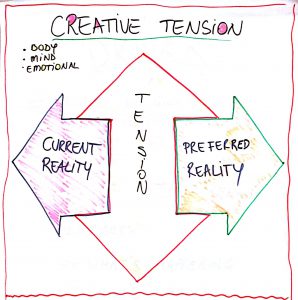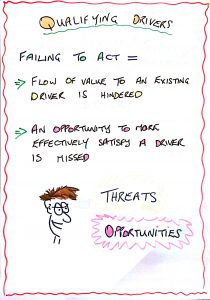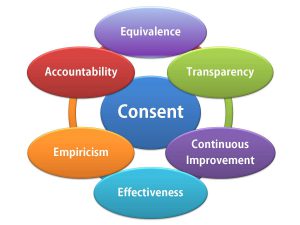Sociocracy 3.0 is a principles based framework of patterns and practices that people can use to improve flow of value and collaborate more consciously, happily and effectively together. All resources are provided free and are available to use and reproduce on a Creative Commons ShareAlike 4.0 License from this website.
Sociocracy 3.0 recognises and builds on the Norms of the classic Sociocratic Circle Method as determined by The Sociocracy Group, whilst at the same time making adjustments to some imperatives stated in the classic Norms. You can read more about why the name Sociocracy 3.0 was chosen, here.
Sociocracy as a term was first coined by August Compte in 1851. Many people have contributed towards the on-going evolution of sociocracy. Of notable significance is Gerard Endenburg, who is perhaps the person most singularly attributable for the evolution of what is known today as the Sociocratic Circle Method.
An integral component of Sociocracy 3.0 is what we refer to as Drivers. This article is intended to give you an introduction to Drivers and related topics.
You’ll find further information about Sociocracy 3.0 at the end of this article.
So, what’s a Driver?
 Driver is the name we give to a situation that motivates us to act. A Driver is most easily described by a brief statement (1 or 2 sentences perhaps) explaining “what’s happening” and “what’s needed”.
Driver is the name we give to a situation that motivates us to act. A Driver is most easily described by a brief statement (1 or 2 sentences perhaps) explaining “what’s happening” and “what’s needed”.
In Sociocracy 3.0 we call this a Driver Statement.
Some example Driver Statements
Although unaware until recently about S3, Wemanity intuitively chose to open their website with a clear Driver Statement (albeit stretched to 4 ‘short’ sentences – which is fine too of course – because anything is fine if it delivers what you want in the way you want it!)
Another example: A team of consultants were motivated to create a strategy for “improving the workplace”:
Driver: Organisations with openness to learning, benefit from greater organisational performance and team happiness. Many organisations fail to recognise and respond to their developmental and learning needs, leading to sustained poor practice, avoidable damage and disillusionment.
Strategy: We champion lifelong learning and the potential for co-creating evolution and continuous improvement. We provide high quality consultancy, coaching and training, and inspire individuals and teams to challenge their working practices and environments without inflicting help.
Navigating via tension
In S3 we talk about navigating via tension. Meaning to pay attention to tensions! We see tensions as symptoms of new information (wisdom) seeking emergence.
Notes:
- I like to suggest that “all perceived problems, challenges and difficulties, are symptoms of wisdom seeking emergence”. If this were true, then imagine, would anything about your current worldview be challenged?
Tensions reveal Drivers
 In order to understand about tension and why we experience it, it helps to understand the tendency to project fantasies of a preferred future reality into current situations. We feel tension when we “perceive” something happening that is different from that which we’d expect or prefer to see. Of course, we don’t have to be clear on the specifics of the future reality we would like, in order to anticipate that a different reality would be preferred.
In order to understand about tension and why we experience it, it helps to understand the tendency to project fantasies of a preferred future reality into current situations. We feel tension when we “perceive” something happening that is different from that which we’d expect or prefer to see. Of course, we don’t have to be clear on the specifics of the future reality we would like, in order to anticipate that a different reality would be preferred.
In an organisational context we want to pay attention to tensions arising in the course of our daily lives and work. As members of organisations we are like nerve endings of the system, picking up changes in the environment. We can either deny and ignore, or acknowledge and respond to these changes.
When we understand tensions as being indicators of potentially valuable information about needs unmet, and when we are in a position to act in creative ways to respond to these needs, then tensions can serves as allies that provide us with a constantly updating feedback loop that in turn can help us to navigate and steer.
Notes:
- Our “perception” of what is happening could be more or less correct. Sometimes we can make assumptions about what we are seeing or sensing. It helps to validate the actuality of situations and this is why in S3, circles (teams of people) consent to Driver Statements as being an accurate enough description of what’s happening and what’s needed.
- When responding to Drivers alone – as we all do in the course of our daily lives – it can sometimes be helpful to get a second opinion on what we perceive is happening. In organisations with a high level of trust, collaboration and cooperation, people naturally communicate more openly. Peer mentoring and regularly talking with others about what we’re doing and why, helps us to learn from one another and expand our points of view.
Clarify & reflect… pause and breathe
Sometimes we mistakenly interpret situations and feel tension on the basis of our assumptions about what is happening. Sometimes we’re already feeling tension due to other factors, and then mistakenly interpret further situations that come to our attention.
The mind can spontaneously fill in missing pieces of a picture, or distort perceptions to fit previous assumptions and experience.
Sometimes we implement strategies on the basis of our past experience, overlooking that a newly emerging situation is different to what we’ve previously experienced.
Basically, we can get into interpretation and reaction, rather than clarification, reflection and response. And the more excited (fight), vulnerable (flight) or tense (freeze) we feel, the more likely we are to fall back on previous assumptions and patterns of behaviour.
Habitually people tend to repeat previously learned strategies, or to come up with spontaneous solutions based on past experience, regardless of how effective that may be.
Some basic steps towards responding rather than reacting:
- Validate the current reality. Check for a mutual understanding on what’s happening. Separate any fantasies from the actuality.
- Establish if by not addressing this new Driver it would result in existing (organisational) Drivers being less satisfied, or opportunities to improve delivery to existing (organisational) Drivers being missed.
- Assuming that item 2) proves the case – use the S3 Proposal Forming Process to tap the collective intelligence of the team and formulate a “good enough for now”, “safe enough to try” agreement about how to move ahead – I mean a viable, iterative, next step.
Note: In simple cases you may opt for presenting an “on the fly” proposal instead – just be sure to establish consent (no objections) for this shorter approach. (Sometimes a quickly made agreement now, could be more efficient in the moment, yet prove less effective in the long-term). More haste, less speed?
- On the basis of your experience, apply learning to continually improving your strategy for delivering value to the Driver, and until such time as the Driver is satisfied.
More about Drivers:
- Some Drivers are on-going. Like the Driver for a restaurant – unless people stop coming, or stop wanting to eat of course!
- All life responds to Drivers. Life continues unchanged until a tension arises. Tensions arise due to opportunity or threat. We (human beings) are Driver sensing organisms with a highly tuned sensitivity to changes in the environment around us. We will more or less consciously, always respond to Drivers.
- People matter! If people are unhappy, disempowered, fearful or otherwise dissatisfied, this will create tension. People need to feel safe and empowered to respond to their needs and in order to remain effective. An organisation navigating via tension realises that addressing human Drivers is important, because an organisation with unhappy, fearful, dissatisfied people, will mean that value delivered to other Drivers will be impeded.
Organisational values:
Different Drivers stand out for us in more or less obvious ways, depending on our values. Values is the name we give to principles we believe are important as guidelines to follow in order to meet needs. The principles we value, directly reflect our beliefs and ideology.
Different people feel tension about different things and depending on what matters to them. This is why it helps to define core organisational values. Sociocracy 3.0 recommends that organisations create a Values Statement.
Of course, all organisations have values of course, only some haven’t made them explicit. Indeed, perhaps some organisations would prefer not to!
- Values define ethical parameters for action.
- Values can offer guidance to determine appropriate action, even in the absence of explicit policy.
- Personally I recommend to keep your core organisational values to a minimum. Jurgen Appelo of Management 3.0 suggests the same.
- Other people like to mention many organisational values. It’s up to you to decide.
The Principles of Sociocracy 3.0
Sociocracy 3.0 has a number of principles. Principles guide action and in some respect they are patterns too. The reason we make a distinction between patterns and principles is because the principles give definition to all other patterns in S3, whereas the patterns do not necessarily give definition to the principles. Another way of putting this is to say that all patterns in S3 are aligned with the Principles.
If an organisations values do not embrace the Principles then they will probably not choose Sociocracy 3.0.
Consent – Decisions are made only in the absence of reasoned objection from those affected by them.
Effectiveness – Devote time only to that which brings you closer to achieving your objectives.
Equivalence – Everyone affected by a decision has the power to contribute towards the formulation of decisions and to withdraw consent on the basis of reasoned objection.
Transparency – All information is accessible to anyone in an organization. Confidentiality requires consent.
Empiricism – Build knowledge on experience and constantly re-evaluated that which is believed to be known on the basis of new experience.
Continuous Improvement – Evolution is more effective than revolution (most of the time).
Accountability – The process of entering and keeping agreements, and managing expectations in any relationship. Note: with equivalence and consent in organisations, people are naturally more accountable.
So, what about purpose?
In S3, purpose is implicit – it’s to satisfy a Driver.
Actually, a purpose exists only in the context of a Driver to define it. Despite this, many teams articulate purpose, yet don’t clarify the Driver that motivated their acting to begin with.
Adding the clarification of a Driver Statement, gives context to purpose.
In fact, adding clarification of a Driver, gives context to just about everything!
Some frameworks encourage a culture of aligning around purpose. Yet if you read the Purpose Statements that some teams compose, they turn out to read like “Mission” Statements, or brief Statements of Intent.
A Mission Statement describes the big picture strategy of how we’re going to get someplace, achieve an outcome, or do something. Intended outcomes paint the picture of what we’d like the consequence of our actions to be.
In S3, things like Mission Statements, statements of intent and deliverables, all fall under the umbrella of strategy.
Deliverables (called “Aims” in classic sociocracy) are the products, raw materials, services, experiences and transformations we create together, with the aim of satisfying needs.
The thing about a Mission Statement – the “how” – is that it doesn’t specifically tell us about – the “why”. The same is true for statements of intent.
By adding the clarification of a Driver Statement, we specifically describe what’s happening and what’s needed.
The purpose, of a mission is to deliver value to some needs or other, in order to change the current reality towards a future reality that those collaborating with it, would prefer to see.
Whichever way we turn, we will always find ourselves coming back to satisfying Drivers again.
On the topic of statements of intent – what about vision?
In S3 we encourage organisations to do what they like, and preferably whatever most serves their needs. Equally we make some recommendations. One recommendation is to consider referring to what might typically be referred to as a Vision, as an “intended outcome” instead.
Whilst an intended outcome could also be referred to as a Vision, a Vision only has relevance in contrast to what currently is. So a Driver is what gives rise to a vision to begin with.
When we start delivering value to needs, we often discover that the future emerges in ways that are different to what we imagined. If an organisation is aligned towards Vision, rather than Driver, then they may continue creating deliverables towards realising the Vision, regardless of whether or not this is flowing value to the Driver that motivated the action to begin with.
By acknowledging that a Vision is an intended (or imagined) outcome, and by focusing delivery of value towards satisfying Drivers, we learn through experience about the consequence of our actions. Organisations that align action towards satisfying Drivers, free themselves to remain dynamic and creative about what they deliver, and open to what the consequences might be. Outcomes may turn out quite different to what we imagined or intended.
When a shared Vision is a Driver
Sometimes people come together specifically to manifest a Vision. However, if we look behind any vision, to why people are motivated to realise it, we discover that people anticipate that it will meet certain needs. Therefore, the fact that a group of people share a common Vision, becomes a part of the “what’s happening” ingredient of a Driver statement. And still, by defining what’s needed too, it frees the group to be flexible on what the emerging future will look like, depending on how effective an emerging future according to the envisioned Vision, turns out to be!
So finally, what happens when we’ve satisfied a Driver?
 By regularly evaluating our actions on the basis of the Drivers that motivated them, we can keep up to date on changes in the current reality and the needs we’re delivering value towards.
By regularly evaluating our actions on the basis of the Drivers that motivated them, we can keep up to date on changes in the current reality and the needs we’re delivering value towards.
Sometimes with Drivers, we discover that we’ve reached a point where the needs have been addressed and the “job” is done.
By recognising when a Driver has been (adequately) satisfied we can easily identify when it’s time to channel energy towards satisfying other Drivers instead.
On a meta level, many organisations and initiatives today exist solely for the sake of their own continuation. For example, manufacturing companies that produce and sell meaningless products to generate profit for profits sake. From one point of view it could be argued that this is fine, I mean, people need jobs right? We’re free to do what we want! Shareholders want to speculate and profit!
Yet look a little deeper and ask yourself, are there any reasons why continuing to do this might have some consequences that harms flow of value to other needs we share as a species?
On the bigger scale, we see our indebted nations (most of them) exercising stimulus in order to prop up declining economies and kick the can a little further up the hill. To put it in a polite way, these are short sighted and ineffective strategies that only stimulate more of the same. Do you feel any tension yet? Do you get a sense that some wisdom that might be seeking emergence?
Numerous Drivers scream out for attention around the world. Yet a majority of people are caught up in tending to basic survival needs, or sustaining the lifestyles that they’re familiar with, providing for family; preparing for older age. A considerable proportion of our human family spend their days toiling for a pittance to feed themselves, with the majority of their precious life energy being absorbed and transformed into profits to feed insatiable cash cows.
What would it look like if we were to pay more attention to the big tensions that have become a part of our daily norms right now, and to recognise then as indicators of needs unmet? What could we achieve it we were to divert energy towards work that is fulfilling, meaningful and resonant with peoples interest, needs and longing? What life-serving principles might we stand by? What are those universal values that every living soul can relate to?
Certainly there are many tensions, and therefore, many opportunities we could leverage and threats we could reduce if we were to free up the energy to do so. Only first we’d need to consider the possibility of doing something different to what we’ve always done. To evaluate the effectiveness of our current activities against the needs that first inspired action to begin with, and to ask if some small incremental changes might serve a longer term gain.
 Are there any adjustments that you might make? Any redirection in how you choose (more or less consciously) to invest your time? These are existential questions, yet it boils down to one simple fact – there are choices and consequences, and what happens next is down to every single one of us.
Are there any adjustments that you might make? Any redirection in how you choose (more or less consciously) to invest your time? These are existential questions, yet it boils down to one simple fact – there are choices and consequences, and what happens next is down to every single one of us.
More about Sociocracy 3.0
Sociocracy 3.0 was discovered and developed initially by myself and Bernhard Bockelbrink. We originally came together to collaborate on creating a free, CC licensed platform of resources about classic sociocracy to address the fact that there was no single place that offered this in a simple, clear way. Whilst preparing to develop the materials, we considered some tensions that groups and organisations were experiencing when seeking to implement classic sociocracy. We also looked at some of the tensions that people experience sometimes with Holacracy – both as a framework, and its approach to implementation – and at some of the challenges associated with scaling Agile and Lean principles and practices.
Through the process of addressing these tensions, we noted the steps we were taking: pay attention to tension ➔ clarify what the situation is ➔ look at what was needed ➔ reflect on existing strategies ➔ consider how to change, improve or create new strategies, to better address what’s needed! And so the phenomena of Drivers came into view and the foundations of Sociocracy 3.0 was born.
Interestingly the foundations of Sociocracy 3.0 turned out to be the very process that we were naturally applying in order to discover it! A process that we’re all very familiar with, because we are doing it all the time!
Sociocracy 3.0 carries no warnings about complexity, is designed to be lightweight and it’s modular. Modular meaning, you can just pull in whichever patterns you need. As with classic sociocracy, or Holacracy, it’s possible to pull in most of the patterns together for a whole system implementation, but not necessarily. Remember, it’s about what works best for you.
Some training and regular practice is definitely helpful to learn Sociocracy 3.0. Developing fluency in applying Sociocracy 3.0 requires much more than just learning some practices. To really integrate the principles and patterns into daily life it invites a change of world view too, and this often requires becoming conscious of, and transforming previously learned, culturally endorsed patterns and mind sets. The simple act of recognising all tensions as symptoms of wisdom seeking emergence, can be both transformational, and challenging!
Throughout the winter of 2015/16 a dedicated team of volunteers will be working to develop further S3 materials towards providing a more comprehensive library of learning and training resources. It’s the intention of the team to provide sufficient materials for people to be able to learn the patterns and practices for themselves.
Bernhard and I both feel strongly that it’s important for people to be able to learn the basics of Sociocracy 3.0, without being dependent on a trainer or consultant in order to do so. Sociocracy 3.0 patterns, and others like them, contribute considerably towards greater effectiveness and equivalence in organisations – qualities that are much needed in our world today.
Funnelling people through monopolised training tracks, restricting basic learning materials, or people’s rights to share them, etc, stands in the way of the free distribution and easy access of these now perhaps vital social technologies. With this in mind, you’re invited to consider how you might contribute some of your time or resources towards helping develop and spread the word about Sociocracy 3.0. And please tell others who you think may be interested, so that they too can have the opportunity to consider whether some of what Sociocracy 3.0 has to offer, could be of value in meeting the Drivers they currently face.
Note: Articles on the basic decision making patterns of Sociocracy 3.0, and for scaling equivalence through organisations and networks, coming soon.
About the author: James Priest is co-founder of Sociocracy 3.0. You can find out more about him and his work at www.thriveincollaboration.com and at www.jamespriest.org

